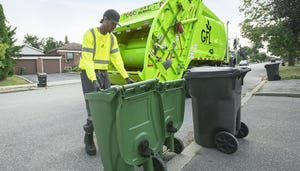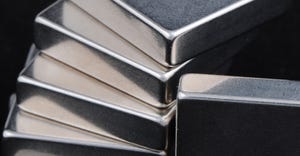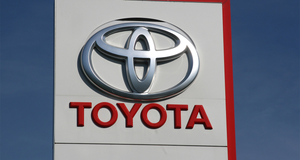Clearing the Air
There's a cloud of uncertainty surrounding the trucks that refuse firms will be buying this year, all of it revolving around the new diesel-engine emission standards designed to promote cleaner air. Yes, trucks will cost more, and, yes, fuel economy will suffer. Yet the real issues confronting refuse fleets may not revolve around money and miles per gallon so much as how exhaust systems are routed, operations altered, and maintenance practices changed to reflect new equipment realities.
“The first thing refuse fleets must do is not be afraid,” says Darry Stuart, president of Wrentham, Mass.-based DWS Fleet Management Services, a firm specializing in fleet maintenance issues. “There's really almost no difference between the truck you bought in 2006 versus the new ones in 2007, other than the price of the truck and some new components.”
Stuart, a veteran fleet manager who spent five years working for the former Browning Ferris Industries (BFI), says the only thing fleets really need to worry about is the new exhaust system and diesel particulate filter (DPF) required to substantially cut exhaust pollution from diesel powered trucks.
“It's really more of a mental issue than anything else,” Stuart says. “You need to change the way you think about operations and maintenance as you bring new 2008 model trucks equipped with 2007 emission-compliant engines into the fleet. For example, you can't make any more ‘backyard’ fixes to exhaust piping now — you must order new pipe from the factory to stay in compliance. Also, the extreme exhaust temperatures created during active regeneration to clean out the DPF can create a fire hazard. You need to make sure no sensitive components or loose debris can get near the exhaust opening.”
Yet DPFs are not a new, unproven technology, Stuart stresses. They've been on buses for years.
Above all, the transition to these new vehicles should be viewed as an opportunity to revisit truck specifications and maintenance practices, Stuart says. While refuse vehicles often are thought of as just ‘trash trucks,’ in reality they have become sophisticated pieces of equipment, and fleets should use this time to re-evaluate their maintenance operations. In doing so, fleet managers shouldn't let cost dictate their decisions.
“For example, there's a new engine oil required for these trucks — CJ-4 — that's more expensive yet more robust than previous blends,” Stuart says. “Upgrade to that oil right away. Pay the small price increase now to take care of your new equipment properly. Don't pay for it later with breakdowns or other problems.”
Spec'ing Sit Down
The first thing experts and trucking manufacturers suggest to fleets is that they sit down with their dealers or OEM representatives to review their truck specifications.
Truck makers have worked closely with body manufacturers to integrate all the configurations refuse fleets use — front loaders, rear packers, roll on/roll offs — into their '08 truck models, which are the first to contain the new '07 emission control systems. Fleets need to make sure they don't alter their specs in such a way as to conflict with the regulations governing the new emission technology, says Melissa Gauger, vocational marketing manager-waste vehicles for Warrenville, Ill.-based International Truck & Engine Corp.
“The important thing to remember is that nothing forward of the DPF on the exhaust system can be modified or moved,” she says. “It's important as you spec the exhaust system to keep that in mind.”
Another critical factor driving exhaust system spec'ing are the higher temperatures generated during active regeneration of the DPF.
The typical stop-and-go operation of refuse vehicles doesn't allow their engine to build up the necessary heat to “passively” clean out the DPF. “That means we're going to see a significant increase in exhaust temperatures during active regeneration — from 800 to over 1,200 degrees Fahrenheit,” Gauger says.
With those kinds of blowtorch temperatures possibly coming from the exhaust system, it behooves fleets to closely examine what other truck components might be affected, as well as everyday items on the street surrounding the vehicle.
“How the exhaust is routed is critical. You don't want those kinds of temperatures blowing on the hydraulic lines controlling the automatic arm that picks up and dumps trash bins, for example,” says David McKenna, Powertrain sales and marketing manager for Allentown, Pa.-based Mack Trucks Inc. “You've got to watch what comes into the proximity of the exhaust opening if you're going to keep using a side-vented system.”
Active regeneration also can create a fire hazard with debris that gets near the exhaust outlet, especially at landfills, says DWS' Stuart. That's why fleets must re-examine their current exhaust system structure to see what issues might develop, he adds.
Both International and Mack offer a “diffuser” that fits over the end of the exhaust to help rapidly cool the exhaust gas during active regeneration. “The diffuser mixes ambient air — the air outside the vehicle — with the hot exhaust gas 12 to 18 inches away from the outlet,” McKenna says. “That'll cool the exhaust gas way down so it does no harm.”
Operations Time
As a fleet puts new trucks with '07 engines and aftertreatment systems into service, a few other important changes must be observed. First of all, the trucks must use ultra low sulfur diesel (ULSD) fuel. Without it, the DPF will plug up prematurely.
ULSD's sulfur content is just 15 parts per million (PPM) compared to the 500-PPM level in today's on-road diesel. The 15-PPM blend is expected to add between 5 and 13 cents to the price per gallon at the pump, according to research by the American Trucking Association (ATA).
As of October 2006, 80 percent of all on-highway diesel fuel available at retail stops must be ULSD, meaning there's still quite a bit of 500-PPM fuel out there, so fleets still must watch closely what they buy for their '08 model trucks.
“You also must use CJ-4 engine oil with these trucks,” adds Gauger. “If you take your vehicles into a dealership for service, they'll know it'll need CJ-4. But if you take care of maintenance in-house, recognize that the '07 package requires CJ-4 use.”
Dan Arcy, technical expect for Houston-based Shell Lubricants, stresses that while CJ-4 oil is going to be more costly than today's CI-4 and CI-4 Plus blends, some perspective is needed. “Prices are not going to double,” he says.
But fleets using extended drains will need to reduce their oil change intervals at least initially in order to see if the new CJ-4 can last as long as its predecessors, Arcy cautions. What are the initial oil drain interval recommendations? Greensboro, N.C.-based Volvo Trucks North America — Mack's sister company — says oil drain intervals for its '07 engines depend heavily on the truck's duty cycle. In general, drain limits for its '07-compliant engines are as follows: up to 30,000 miles for its new 11-liter D11 engine, up to 45,000 miles for the 13-liter D13 and up to 50,000 miles for the 16-liter D16. Those intervals should roughly translate to Mack's MP7, MP8, and soon-to-be released MP10 engine models as well.
Driver training is going to be critical as well, mainly to identify when active regeneration of the DPF is needed and what drivers must do when active regeneration is required. That will depend in large part on the truck brands involved.
For example, International requires its trucks to pull over for 20 minutes as the engine revs up to create the extra heat needed to complete the active regeneration cycle. Mack, by contrast, uses a special thermal regeneration device at the base of its DPF to physically raise the heat in the filter, so the operator does not have to stop the vehicle at all.
“Based on our testing, we think a refuse vehicle is going to need to go through a 20-minute active regeneration cycle twice a day,” says Mack's McKenna. “Even the most extreme stop-and-go operation won't require more than three active regeneration cycles per day.”
To give refuse vehicle operators more flexibility, most OEMs are including a manual override switch to delay active regeneration to allow the driver to find a spot that is both safe for the driver to pull over and that won't be affected by high exhaust temperatures.
Drivers also will get a series of visual warning indicators they must recognize. For example, International vehicles will have a series of four lights that tell the driver how urgently the vehicle needs to undergo active regeneration. When the fourth light — which is a solid red color — flashes, the DPF is too full to be cleaned out by regeneration, so the truck must be towed to a dealer for service.
Maintenance Matters
The final stop on a fleet manager's '07 checklist is the maintenance shop. First, in terms of additional maintenance checks needed for all of the new emission control systems — including the computer controls and wiring harnesses — Redford, Mich.-based engine maker Detroit Diesel Corp. said fleets should expect to spend an average of an additional $367 per year.
Then there's DPF cleaning: though active regeneration cleans out the soot trapped in the DPF, it doesn't get rid of ash, which is residue left behind from the small amounts of engine oil that get into the engine cylinder and are vaporized during combustion. Based on test results, most truck manufacturers believe DPFs will need to be cleaned out when a truck accumulates anywhere from 150,000 miles to 400,000 miles on its odometer — or anywhere from 3,000 to 4,500 engine hours. The cost to clean them out has a pretty broad range as well, from $150 (cited by Volvo) to between $300 and $500 per transaction (according to Detroit Diesel).
Most truck OEMs plan to handle DPF cleaning needs via an exchange system: the fleet removes the full DPF from the vehicle, puts it in a sealed container and exchanges it for a new DPF at the local dealership. “There's a core charge associated with this, just like with other components such as batteries, water pumps, etc.,” says Mack's McKenna. “The exchange system is familiar to fleets so no one should have any issues using it.”
One thing fleets need to remember is the fine ash contained within a full DPF is considered hazardous waste by one state: California. That's why OEMs are providing a variety of plastic “pails” and other containers to seal full DPFs in. Recognize, too, that even in states where the fine ash isn't considered hazardous, it can still create a mess, so use the container.
Finally, fleets need to recognize that more electronics are going to be involved across the board — especially for the DPF, McKenna says. “Most of us OEMs have designed the DPFs to be self-diagnosing. There are sensors everywhere to make sure that if there's a problem, it'll be able to tell the operator and maintenance personnel what it is,” he explains.
Add everything up and refuse fleets should take a fresh look at their maintenance programs so they'll be ready to handle the extra requirements of '07 emission control components, DWS's Stuart says. “This is a good time to revisit your maintenance program, to make sure you address all the extra electronics and components involved with '07 emissions. Adjustments to your maintenance procedures now will help you avoid more serious issues down the road.”
Sean Kilcarr is senior editor for Waste Age's sister publication, Fleet Owner.
About the Author(s)
You May Also Like


